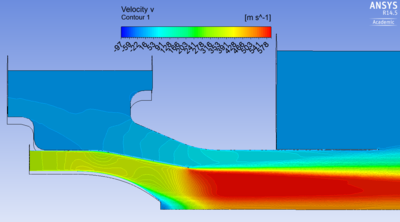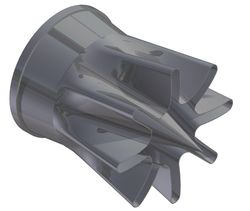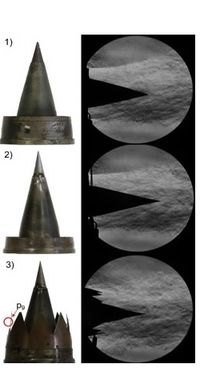Nozzle Flow
The Component
The nozzle of a turbojet converts the remaining flow power after the turbine into thrust. Thus, the nozzle is an important component for propulsion. In most engines, the nozzle is a separate component and thus easy to dismantle. This means that different nozzle designs can be tested without modifying the engine itself. Since the structural loads are relatively limited, heat-resistant steels are sufficient.
The Ejector Nozzle Concept
The ejector nozzle concept is based on the operating principle of a jet pump, as known from a Bunsen burner. The fast outgoing flow creates negative pressure, which sucks in additional air from the outside. In the mixing tube, the slow flow is accelerated and the fast flow is decelerated through impulse exchange. When mixing is complete, the primary and secondary mass flows leave the ejector nozzle at the same speed and temperature.

In the equation of the jet power of the flow, the velocity enters quadratically and the mass flow linearly, while in the thrust equation both are only linear. Thus, with a higher mass flow and a lower flow velocity, more thrust is obtained from the same flow power.
| Possible positive Effect | Problem |
| Mass flow increase with the same power → More thrust/better TSF | Low efficiency for pulse exchange |
| Reduction of the exhaust gas temperature | Strong reduction of the effect at airspeed → Reverse effect on the cyclic process |
| Increase in advance efficiency | Change in pressure conditions at the nozzle outlet |
| Easy to retrofit/no moving parts | Additional weight due to attachment |
Numerical Investigation
In a previous bachelor thesis, the standard nozzle of a 300N engine was already simulated numerically with a structured mesh. In a subsequent work, the simulations were made with an unstructured mesh and the results were compared with the structured one. Afterwards, an ejector was added to the nozzle and various parameters of the ejector, such as diameter, length and inlet cross-section, were varied.

Furthermore, geometry variations of the nozzle itself and the inner cone were also investigated in order to reduce existing flow separation and losses.
Experimental Investigation of the Standard Nozzle
On the test rig of a 200N engine, measurements were taken of the fluidic condition at the nozzle outlet, and visual images of the flow were taken with the aid of streak optics.
Measurement of Different Nozzle Geometries
In addition to the measurement with the standard nozzle, different nozzle geometries were also investigated, a shorter (2) and a chevron nozzle (3). In addition to recording the static pressure directly at the nozzle outlet, schlieren optics images provided information about the changed flow condition. The chevron nozzle in particular produced a demonstrably increased negative pressure behind the nozzle. In addition, the improved mixing properties due to a more turbulent shear layer became apparent.


Testing the ejector nozzle
The project group published a scientific paper on the numerous theoretical and practical results obtained so far on the subject of the ejector at the annual DLRG congress in September 2015. According to the parameters presented therein, an ejector nozzle prototype for the 200N engine is now to be designed and manufactured.
The nozzle should provide a thrust increase of 5-10 %. For this purpose, thrust measurements with variations in the distance of the ejector nozzle and the length of the mixing tube will be carried out.
Later on, the ejector nozzle is to be supplemented by a bloom mixer on the standard nozzle of the 200N engine. The increased mixing speed and the resulting shorter mixing tube could increase the thrust boost to 15-20%. The idea goes back to a 1999 patent for the thrust-boosting AlternatingLobeMixerEjectorConcept (ALMEC system) for small-bypass commercial aircraft. Testing on a Gulfstream GII resulted in a 7% increase in static thrust. Due to the much higher exhaust gas velocity of the small turbojets, a higher thrust boost is to be expected.
